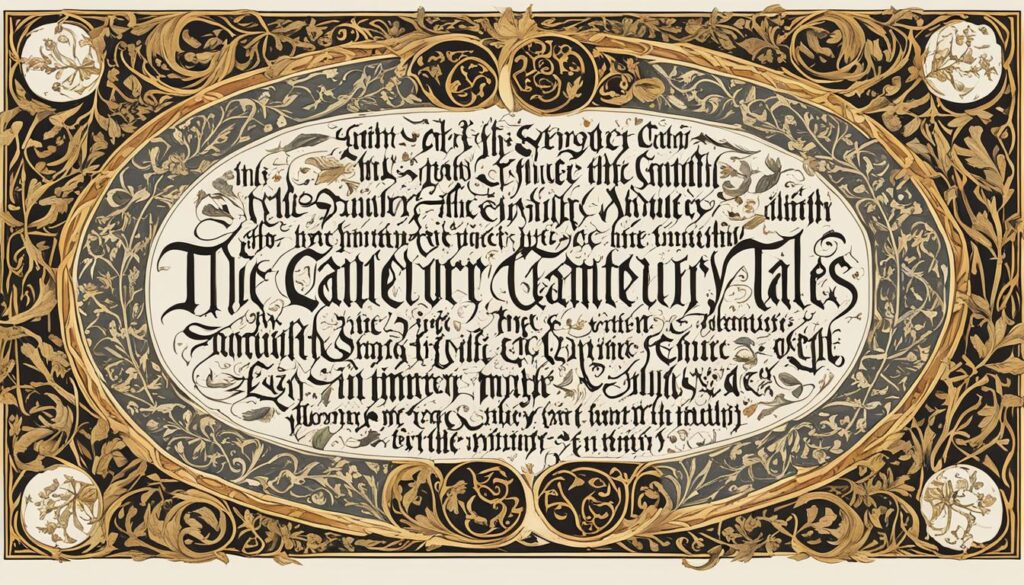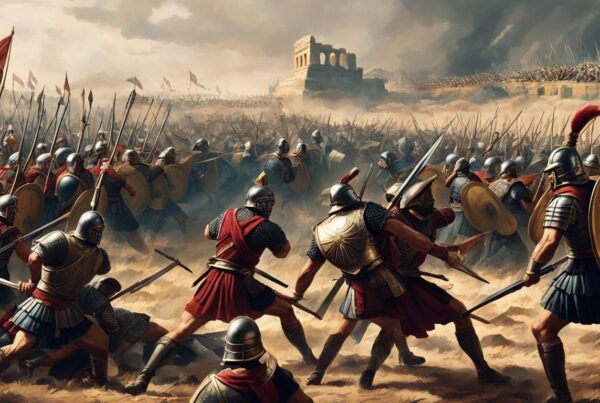In this audiobook review, we will take a closer look at “The Canterbury Tales” by Geoffrey Chaucer. Set in the 14th century, this literary masterpiece has stood the test of time and remains a beloved classic to this day. Join us as we dive into the world of Chaucer’s captivating characters and explore the unique experience of listening to “The Canterbury Tales” audiobook.
Whether you’re a longtime fan of this iconic work or a newcomer who’s never read it before, the audiobook version of “The Canterbury Tales” offers a fresh perspective on this timeless tale. In the following sections, we’ll examine the plot, characters, language, and historical context of Chaucer’s work, as well as the production quality and performance of the audiobook. We’ll also provide a recommendation for potential listeners and explore the availability and pricing options for this adaptation.
If you’re curious about “The Canterbury Tales” audiobook, or simply looking for a new literary adventure, this review is for you. Let’s begin!
Overview of “The Canterbury Tales”
Considered a masterpiece of English literature, “The Canterbury Tales” is a collection of 24 stories written by Geoffrey Chaucer in the late 14th century. The stories are set within a frame narrative of a group of pilgrims travelling to the shrine of Saint Thomas Becket in Canterbury. The pilgrims come from different social classes and professions, and they each tell a story on their way to the shrine.
Chaucer’s work provides a rich portrayal of medieval life and society, exploring themes such as love, religion, gender, and class. The colorful cast of characters reflects the diversity and complexity of the time period, and Chaucer’s writing style, which employs both humor and satire, makes for an engaging and entertaining read.
Throughout “The Canterbury Tales,” Chaucer weaves together a variety of literary genres, from romance and allegory to fabliau and morality tale. His use of Middle English, the language of the time, adds to the authenticity and richness of the work.
Overall, “The Canterbury Tales” is a classic work that continues to be celebrated and studied today for its historical significance, literary value, and timeless themes.
Plot Summary
Set in the 14th century, “The Canterbury Tales” by Geoffrey Chaucer follows a group of pilgrims as they travel from London to Canterbury to visit the shrine of Saint Thomas Becket. Along the way, they engage in a storytelling contest, each sharing a tale that reflects their personal values, beliefs and experiences.
The pilgrims come from various walks of life and include a knight, a miller, a prioress, a clerk, and a merchant, among others. Their stories range from romance and comedy to tragedy and satire, providing a colorful and diverse collection of literature.
The tales are interspersed with scenes of the pilgrims interacting with one another, revealing their personalities and relationships. As the journey progresses, tensions arise, secrets are revealed, and unexpected alliances are formed.
The book ends before the pilgrims arrive at their final destination, leaving their fate unknown and inviting speculation about their ultimate outcomes.
Historical Context
The Canterbury Tales is set in the late 14th century against the backdrop of a dynamic, changing England. At this time, the country was transitioning from the Middle Ages to the Renaissance, and the world was experiencing significant social, cultural, and political transformations.
The feudal system was still predominant and England was emerging from the Black Death, a plague that ravaged the population. Meanwhile, the Hundred Years’ War with France was ongoing and the country was experiencing significant religious turmoil as a result of the papacy’s move to Avignon. These were the times when Chaucer wrote The Canterbury Tales.
“And of a staff he baar noght worth a fille,
For burdening him with a fume of ale.”
— Chaucer, “The Canterbury Tales” (Prologue, 141-142)
Chaucer’s work reflects these major events and changes, capturing the intricacies of medieval life, politics, and social norms. The tales provide a fascinating insight into the complex cultural landscape of England at that time. This historical context is crucial for understanding the nuances of Chaucer’s work and his powerful influence on the development of English literature.
Writing Style and Language
Geoffrey Chaucer’s writing style in “The Canterbury Tales” is an adept mix of narration, description, and dialogue that captures the essence of the 14th century. Chaucer’s use of Middle English, a language that has evolved significantly over the centuries, adds to the foundational layer of the text’s richness and authenticity. While some may find the language challenging, it ultimately enhances the storytelling experience and immerses listeners in the world of the pilgrims.
Chaucer employs various storytelling techniques, such as satire, irony, and allegory, that convey his social commentary on the church and the society of his time. The work is known for its humor, crude humor, and bawdiness, which are used instrumentally in the different tales to reflect the complexity of human nature.
The language of Chaucer’s work might at first appear strange to the modern listener, but it is the beauty and mastery of language on display. The careful use of syntax and wordplay is a testament to Chaucer’s skill as a writer.
The Table below presents some of the most frequently employed literary devices in “The Canterbury Tales.”
| Literary Device | Description |
|---|---|
| Satire | A literary technique used to expose and criticize foolishness and corruption in society, often humorously. |
| Irony | A figure of speech in which words are used in such a way that their intended meaning is different from the actual meaning of the words. |
| Allegory | A narrative technique in which characters and events represent abstract ideas and themes. |
| Mood | The emotional tone that a work conveys to the listener. In “The Canterbury Tales,” Chaucer creates a variety of moods, from humor to seriousness, to provide a multi-faceted narrative. |
Chaucer’s use of language and literary techniques has made “The Canterbury Tales” a literary masterpiece that has stood the test of time.

Themes and Motifs
Geoffrey Chaucer’s “The Canterbury Tales” is an iconic work of literature that explores a wide range of themes and motifs. One of the central themes of the work is love and marriage, which is evident in several of the tales.
The Knight’s Tale, for example, follows the story of two knights who fall in love with the same woman, leading to a competition for her affections. The Miller’s Tale, meanwhile, explores the theme of infidelity and deceit, as a young wife conspires to cheat on her older husband.
In addition to love and marriage, Chaucer delves into the complexities of social class and morality throughout “The Canterbury Tales.” The Friar’s Tale, for instance, satirizes the corruption of the Church and the clergy, while the Pardoner’s Tale questions the morality of greed and materialism.
Furthermore, recurring motifs throughout the work add depth and significance to the various tales. One such motif is the idea of disguise and deception, which is present in several of the tales such as the Miller’s Tale and the Reeve’s Tale.
Character Analysis
The characters in “The Canterbury Tales” are a diverse group that reflects the social structure of 14th-century England. From the pious to the corrupt, each character brings a unique perspective to the narrative. Here, we analyze the most prominent characters and their roles in the tales.
The Knight
The Knight is a chivalrous and honorable member of the nobility. He represents the ideal of medieval knighthood, embodying virtues such as loyalty, courage, and respect for authority.
“Of his port as meke as is a mayde.
He never yet no vilanie ne sayde
In all his lif, unto no manere wight.
He was a veray, parfit gentil knyght.”
Chaucer’s portrayal of the Knight highlights the values and expectations of medieval society, where honor and nobility were prized above all else.
The Pardoner
The Pardoner is a corrupt and deceitful member of the clergy. He sells pardons and indulgences to people seeking forgiveness, exploiting their fears and vulnerabilities for personal gain.
“But sooth to seyn, I noot how men hym calle;
He was as angry as is a palled ale,
And ful of jargon as a flekked pie.”
Chaucer uses the Pardoner’s character to criticize the corruption and hypocrisy of the Church, which was a common theme in his time.
The Wife of Bath
The Wife of Bath is a confident and outspoken woman who has been married five times. She challenges the traditional role of women in medieval society and advocates for their rights and independence.
“Experience, though noon auctoritee
Werre in this world, were right ynogh to me,
To speke of wo that is in mariage.”
Chaucer’s portrayal of the Wife of Bath is revolutionary in its rejection of conventional gender norms. Her character represents a feminist voice ahead of its time.
| Character | Description |
|---|---|
| The Knight | Chivalrous and honorable member of the nobility |
| The Pardoner | Corrupt and deceitful member of the clergy |
| The Wife of Bath | Confident and outspoken woman challenging traditional gender roles |
The characters in “The Canterbury Tales” are vivid and complex, adding depth and richness to Chaucer’s storytelling. Through their personalities, motivations, and experiences, we gain a deeper understanding of medieval society and the human condition in general.
Narration and Performance in the Audiobook
Listening to “The Canterbury Tales” on audiobook provides a unique and immersive experience, bringing Chaucer’s stories to life through narration and performance. A skilled narrator can enhance the storytelling, capturing the nuances of the characters and drawing the listener into the narrative.
The audiobook version of “The Canterbury Tales” is narrated by acclaimed actor and voice artist Richard Bebb. Bebb’s deep and resonant voice adds an authoritative quality to the stories while his versatile range of accents and intonations brings the diverse cast of characters to life.
The performance of the audiobook is further enhanced by the use of music and sound effects throughout the recording. From the sound of a horse-drawn carriage to the lively melodies of a folk tune, the sound design adds a layer of depth and dimension to the storytelling.
All these elements combined make for a captivating and engaging listening experience that adds a new perspective to this classic piece of literature.
“The narrator’s ability to capture the essence of each character and the use of sound effects make this audiobook an excellent adaptation of Chaucer’s work.”
Audiobook Production Quality
The “Canterbury Tales” audiobook offers a high-quality production that captures the essence of Chaucer’s work. The sound engineering is impeccable, providing a clear and immersive listening experience. The narrator’s pacing is also exceptional, allowing listeners to fully engage with the storytelling and appreciate the nuances of each character.

“The production quality of the audiobook exceeded my expectations. The sound effects and music added an extra layer of depth to the classic tales. A truly immersive experience”
Overall, the production quality of “The Canterbury Tales” audiobook is top-notch, making it a worthy adaptation of Chaucer’s literary masterpiece.
Reception and Impact
Geoffrey Chaucer’s “The Canterbury Tales” has enjoyed an enduring legacy since its publication in the late 14th century. With its distinct blend of humor, storytelling, and social commentary, the work has garnered praise from literary scholars and everyday readers alike.
The impact of “The Canterbury Tales” extends beyond its literary merits, as it has also contributed to the evolution of the English language. Chaucer’s use of the vernacular Middle English, as opposed to the more formal Latin or French, helped to standardize the language and make it more accessible to the general public.
Over the years, “The Canterbury Tales” has undergone numerous adaptations and translations, including several successful film and stage productions. However, the work has also faced criticism for its content, particularly its depiction of gender and religious groups.
“The Canterbury Tales” is a literary masterpiece that continues to captivate audiences and influence cultural representations of medieval England.
Notable Mentions
| Year | Event | Description |
|---|---|---|
| 1476 | First Printed Edition | William Caxton produces the first printed edition of “The Canterbury Tales,” allowing for wider distribution and solidifying its place in English literature. |
| 1950s | Modern Translations | Several new translations of “The Canterbury Tales” are published, bringing the work to a new generation of readers. |
| 1980s | Television Adaptation | A popular television adaptation of “The Canterbury Tales” brings the work to life for a new audience. |
| 2012 | Interactive Website | The British Library launches a website that allows users to explore digital copies of original manuscripts of “The Canterbury Tales.” |
Despite its centuries-old origins, “The Canterbury Tales” continues to captivate and inspire readers worldwide, making it a testament to Chaucer’s enduring legacy.
Comparisons to Other Adaptations
While “The Canterbury Tales” has been adapted into various medium, the audiobook format allows for a unique experience of Chaucer’s storytelling. Unlike film or stage adaptations, the audiobook enables the listener to fully immerse themselves in the text, with no distractions from visuals or stage direction. However, the lack of visual cues may cause some listeners to miss out on certain aspects of the narrative.
“The audiobook version of ‘The Canterbury Tales’ is a delightful and engaging way to experience this classic work. It captures the wit and satire of Chaucer’s original text, and brings the characters to life in a way that other adaptations simply can’t match.”
While the audiobook format may be the most immersive way to experience “The Canterbury Tales,” it’s worth comparing to other adaptations for a more comprehensive understanding of Chaucer’s work. Here is a table summarizing the pros and cons of different adaptations:
Film Adaptations
Many films have been made based on “The Canterbury Tales,” but most adaptations only focus on one or a few of the tales, rather than the entire collection. One advantage of film adaptations is that they can add elements that the original text may lack, such as music, special effects, and cinematography. However, these additions may also take away from the authenticity of the story.
Stage Adaptations
Stage productions of “The Canterbury Tales” often involve a live performance of the tales, either through individual actors or a chorus. This format allows for a more interactive experience and can highlight the humor and satire present in Chaucer’s work. However, it also requires a skilled cast, director, and production crew to successfully convey all the nuances and complexities of the text in a live setting.
Summary
While “The Canterbury Tales” has been adapted into various formats, the audiobook version provides a unique and immersive experience. However, each adaptation has its own advantages and disadvantages, and it’s ultimately up to the reader or listener to decide which medium best captures the essence of Chaucer’s storytelling.
Pros and Cons of the Audiobook
The “Canterbury Tales” audiobook by Geoffrey Chaucer offers a unique way to experience this classic literary work. However, like any form of media, there are both pros and cons to listening to an audiobook. Here, we explore some of the advantages and disadvantages of choosing this audio format:
Pros:
- Accessibility: Audiobooks are incredibly convenient for those who struggle with reading or have visual impairments. This format makes the story accessible to a wider audience.
- Convenience: With an audiobook, you can listen to the story while completing other tasks, such as exercising or commuting. It can be a great way to multitask and maximize your time.
- Performance: A well-done audiobook can enhance the storytelling experience. Voice actors can bring the characters to life and use accents and inflections to differentiate them from one another. It can add a new dimension to the reading experience.
Cons:
- Limited visual elements: With an audiobook, you miss out on any visual elements that may enhance the storytelling experience. With “The Canterbury Tales,” there are illustrations that accompany the text that may be missed in the audio format.
- Pacing: Audiobooks move at a consistent pace, which may be slower or faster than a reader’s preferred pace. This can be frustrating if you find the narration too slow or too fast.
- Availability: While audiobooks are becoming increasingly popular, not all literary works have an audiobook format available. This can limit your options when choosing what to listen to.
Overall, choosing to listen to “The Canterbury Tales” audiobook is a matter of personal preference. Consider the pros and cons before making your decision. If you value accessibility, convenience, and performance, then this audiobook may be the perfect fit for you. However, if you don’t want to miss out on any visual elements or prefer a different reading pace, then you may want to opt for the physical book instead.
Recommendation and Target Audience
After careful consideration, we recommend “The Canterbury Tales” audiobook to literature enthusiasts who appreciate classic works with rich storytelling and historical significance. This adaptation is suitable for individuals who prefer to listen to literature rather than read it. The audiobook format enhances the narrative and brings the characters to life, making it ideal for those who enjoy immersive experiences.
However, due to its use of Middle English and complex themes, the audiobook may not be suitable for all audiences. We suggest that individuals with an interest in medieval literature and history, as well as advanced readers, would benefit the most from this adaptation.
Audiobook Availability and Pricing
If you’re interested in listening to “The Canterbury Tales” audiobook, there are several options available. You can purchase the audiobook in various formats, including CD, MP3, and digital download. It’s also available on several platforms, including Audible, Amazon, and iTunes.
The price of “The Canterbury Tales” audiobook varies depending on the format and platform you choose. The prices range from $10 to $30. Keep an eye out for sales or discounts, which may reduce the cost even further.
If you’re unsure about which format or platform to choose, it may be helpful to read reviews or compare prices and features. With so many options available, you’re sure to find a version of “The Canterbury Tales” audiobook that fits your preferences and budget.
Conclusion
Overall, “The Canterbury Tales” audiobook by Geoffrey Chaucer is a literary masterpiece that seamlessly blends history, storytelling, and character development. The audiobook format adds an extra layer of immersion, bringing each tale to life through expert narration and performance.
Throughout this review, we’ve explored the various elements that make “The Canterbury Tales” such an enduring classic, from its exploration of love, morality, and social class to its historical significance. We’ve also analyzed the audiobook’s production quality and compared it to other adaptations.
As literature enthusiasts, we highly recommend “The Canterbury Tales” audiobook to anyone looking for a captivating listening experience. Whether you’re a fan of Chaucer’s work or new to the world of medieval literature, this audiobook is sure to leave a lasting impression.
If you’re an avid audiobook listener looking for a new adventure, “The Canterbury Tales” is a worthy addition to your collection. It’s perfect for those who enjoy rich, character-driven storytelling and historical fiction.
Overall, “The Canterbury Tales” audiobook is a must-listen for any literature lover who wants to experience one of the greatest works of literature from the 14th century in a new and exciting way.



